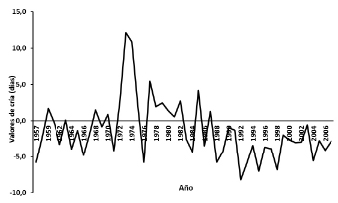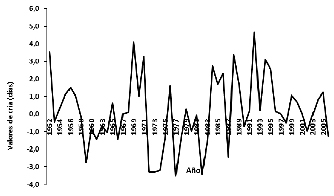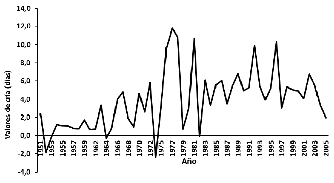
ORIGINAL
Heritabilities and genetic trends for reproductive traits in a population of Romosinuano cattle in Colombia
Heredabilidades y tendencias genéticas para características reproductivas en una población de ganado Romosinuano en Colombia
Oscar Vergara G,1* Dr.Sc, Gustavo Ossa S,2 Ph.D, Julieth Cabrera A,1 MVZ, Juan Simanca S,1 Esp, Juan Pérez G,2 Esp.
1Universidad de Córdoba, Faculty of Veterinary and Zootechnical Medicine, Tropical Animal Production Research Group, Montería, Colombia.
2Corporación Colombiana de Investigaciones Agropecuarias CORPOICA, National Program for Animal Genetics and Biotechnology, C.I. Turipaná, Cereté, Colombia.
*Correspondence: overgara@correo.unicordoba.edu.co
Received: August 2014; Accepted: July 2015.
ABSTRACT
Objective. The aim of this study was to estimate heritabilities and genetic trends for reproductive traits in a beef cattle population Romosinuano. Material and methods. Age at first calving (AFC), first calving interval (FCI), and second calving interval (SCI) were evaluated from a database generated from 1951 to 2011 by Research Center Turipana. Unicaracter animal model was used, which included fixed of contemporary group (year-season), random direct genetic additives effects and residual. Estimates of variance components and genetic parameters were obtained through Restricted Maximum Likelihood procedure, using AIREMLF90 program. Genetic trends were calculated as a linear regression of weighted averages of breeding values over the years, using the REG procedure of Statistical Analysis System. Results. The indices of heritability for additive genetic effects were 0.04 ± 0.05 for AFC, 0.06 ± 0.06 for FCI, and 0.09 ± 0.06 for SCI. Conclusions. Low heritabilities indicating that should improve nutritional and management conditions in the herd, so that they can better express the traits evaluated. The estimated genetic trends were near zero, which shows that the objective of the CI Turipaná regarding this population has complied fully preserving the genetic variability of the breed Romosinuano.
Key words: Additive genetic, creole, EPDs, reproduction (Source: CAB, USDA).
RESUMEN
Objetivo. Estimar heredabilidades y tendencias genéticas para características reproductivas en una población de ganado Romosinuano. Materiales y métodos. Se evaluaron los registros de edad al primer parto (EPP), primer intervalo entre partos (PIEP) y segundo intervalo entre partos (SIEP), desde el año 1951 hasta 2011 de ganado Romosinuano del Centro de Investigación Turipaná. Se empleó un modelo animal unicaracter que incluyó los efectos fijos del grupo contemporáneo (año-época de nacimiento), efectos aleatorios genéticos aditivos directos del animal y residual. Las estimaciones de los componentes de varianza y los parámetros genéticos se obtuvieron a través del procedimiento de Máxima Verosimilitud Restringida, mediante el programa de AIREMLF90. Las tendencias genéticas fueron calculadas como una regresión lineal de las medias ponderadas de los valores genéticos sobre los años, usando el procedimiento REG de Statistical Analysis System. Resultados. Los índices de heredabilidad para efectos genéticos aditivos directos fueron 0.04±0.05 para EPP, 0.06±0.06 para PIEP y 0.09±0.06 para SIEP. Conclusiones. Las heredabilidades bajas indican que se debe mejorar las condiciones de nutrición y de manejo en el hato para que se puedan expresar mejor las características evaluadas. Las tendencias genéticas estimadas arrojaron valores cercanos a cero, lo cual demuestra que el objetivo del C.I Turipaná con respecto a esta población se ha cumplido a cabalidad, preservando la variabilidad genética de la raza Romosinuano.
Palabras clave: Criollo, DEPs, genético aditivo, reproducción (Fuente: CAB, USDA).
INTRODUCTION
The profitability of a cattle company requires the use of highly productive animals but they are adapted to the environment where they are handled (1). The age at first calving and calving intervals are two highly important parameters in assessing the reproductive efficiency of cattle populations. These two parameters in native cattle breeds reveal their potential to adapt to environmental conditions, which is greatly important in estimating the reproductive performance of these animals (2).
The study and knowledge of genetic parameters of reproductive traits of the Romosinuano breed are indispensable to not only better understand the breed, but also to develop and implement conservation and breeding programs that contribute to creating competitive and sustainable livestock systems in the areas of influence of the breed.
On the other hand, heredability of most reproductive traits in beef and milk cattle are low. However, this does not imply that genetic gain in reproductive performance is not possible (3). For this reason, the objetive of this study was to estimate heritability and genetic trends for traits of age at first calving and first and second calving intervals for the Romosinuano breed at the Turipaná Research Center.
MATERIALS AND METHODS
Location. The study was conducted at the Turipaná Research Center (CORPOICA) located in Cereté, Cordoba, Colombia. The area belongs to the agro-ecological classification of tropical rainforest located at 75°42’ W and 8° 50’ N, 20 meters above sea level, average temperature 28°C, relative humidity 83% and annual rainfall of 1200 mm.
Animals and data. For age at first calving (AFC), 1079 records collected from 1957 to 2007 were used, for first calving interval (FCI) and second calving interval (SCI) 894 and 813 records were used from the year 1957-2011 from the database generated by the Turipaná Research Center for the Romosinuano breed.
Currently, at the Turipaná Research Center, animals from the Romosinuano breed are handled in a system of alternating or rotational grazing meadows with Angleton (Dichatum aristatum) and Tanzania (Panicum sp) and a permanent supply of mineral salt and water. During the dry season the animals receive a corn silage supplement. It has a mating system circulate between cow and bull, which prevents an increase of inbreeding.
Data were analyzed using single trait models, and variance and covariance components were estimated using the Restricted Maximum Likelihood procedure. AIREMLF90 (4.5) software from the University of Georgia was used, which uses the average information algorithm. The following animal model was used:
y=Xβ + Za + e
Where:
y = observation vector for AFC, FCI or SCI;
β = vector of fixed effects for contemporary group (year-season of birth);
a = vector of additive direct genetic random effects;
e = residual vector;
X = incidence matrix relating records to fixed effects of contemporary group;
Z= incidence matrix relating records to additive direct genetic random effects.
Genetic trends were calculated as a linear regression of the genetic values averages for the respective years, using the REG procedure of Statistical Analysis System - SAS (6). This program also was used to depurate the database.
RESULTS
The averages for AFC, FCI and SCI are presented in table 1. The heritability for AFC was 0.04±0.05, for FCI to 0.06±0.06 and for SCI 0.09±0.06.
Table 1. Average (days) age at first calving, first interval between calving and the second
calving interval.

Genetic trends for AFC, FCI, and SCI can be observed in figures 1, 2 and 3, respectively.

Figure 1. Genetic trends for age at first calving, according to the cow’s year of birth.

Figure 2. Genetic trends for the first calving interval, according to the cow’s year of birth.

Figure 3. Genetic trends for the second calving interval, according to the cow’s year of birth.
In table 2, regression equations for trends in genetic traits under study are observed. Additionally, genetic tendency to FCI was not significant, but just the opposite occurs in AFC and SCI.
Table 2. Genetic trends of reproductive traits.

DISCUSSION
Age at first calving (AFC). The estimated average for AFC was 38.61 ± 9.52 months, a similar result (38.21 and 36.8 ± 4.7 months) to reports by Ossa et al (2) and Rocha et al (7) for Romosinuano and Blanco Orejinegro cattle, respectively. Similarly, several studies carried out in Colombia and other countries with different cattle breeds found similar results (37.7 ± 10.1; 36.36 ± 4.9 and 38.9 ± 3.9 months) to those in this study (8-10). Martinez et al (11) and Azevedo et al (12) found lower results (32.5 ± 6.24 and 34.58 ± 6.21 months) in Sanmartinero and Chianina cattle, respectively.
AFC obtained in this investigation is considered acceptable given the production system based on grazing on grasses with average nutritional quality and the effect of environmental factors on availability of forage during some months of the year, confirming the ability of the Romosinuano breed to adapt to adverse conditions in the Colombian tropics. This adaptability provides increased productive life of cows, that expressed in terms of profitability, will enable a greater amount calves per cow in the herd. However, a much lower value for this trait by providing better food and nutrition and implementing good management practices for heifers.
The estimated heritability of AFC was similar to that reported by Espinoza et al (8) in a population of Zebu cattle (0.09) in Cuba. While Ossa et al (2) and Suarez et al (13) found higher heredability values (0.16 ± 0.086 and 0.16 ± 0.08) than those in this study in the Romosinuano breed. Several studies carried out in other breeds of beef cattle in different regions of this country and others reported higher heritability values for AFC (0.15 ± 0.026, 0.14 and 0.15 ± 0.01) than those in this study (7, 14, 15).
According to the estimated heritability value for AFC, these types of variations depend only 4% on the differences between animal additives and 96% on other sources of variation. Most scientific papers that have studied reproductive traits in cattle have reported lower inheritance values, which they attribute to environmental influences or because reproduction is mainly controlled by non-additive genetic effects, so a good response to selection for this trait is not expected (2, 7, 8, 13-15).
Genetic trend values for AFC showed very variable behavior during the assessment period, where it can be observed (Figure 1) that over the years there is a decreasing trend, with an average annual decrease of -0.08581 ± 0.03807 days/year (p=0.0288; Table 1). This annual value is less than what is reported by Ossa et al (16), who reported results of -0.33 days/year when evaluating the same breed, using records from the same research center that this study used, but over different time periods. Similarly, Martinez et al (11), obtained an average annual decrease of 16.71 days in a study of Sanmartinero cows.
As shown, the annual genetic trend of direct genetic effects was negative and significant, although close to zero, indicating that during the period evaluated for this trait there has been little genetic variability. This may be because the herd belonged to a national conservation program where the aim is to maintain genetic variability, where a circular mating system is possibly used, as well as introducing replacements cows and bulls that have conditioned this trait’s stability and possibly conserved genetic variability.
First and second calving interval (FCI and SCI). The mean FCI obtained in this study was lower than those reported by several authors (547 ± 142, 469 ± 9 475 ± 114, 517 ± 4 and 458 ± 96 days, respectively) in different breeds of beef cattle (7 10-12, 17). The average SIEP was lower than that reported by Rocha et al (7) for Blanco Orejinegro cattle (487 ± 132 days), and Silveira et al (17) in Nellore cattle (453 ± 4 days).
The average FCI and SCI for animals in this study is considered good, since in terms of production it represents a birth rate between 85 and 92%. Therefore, it is important to note that reproductive traits reflect how an animal adapts to a production system in a given environment (11). The CI is the most important reproductive manifestation in any animal production system and its importance derives from the regular production of calves, which is the primary objective of any meat or milk producing system, and this is achieved by seeking an ideal CI over 365 days to maximize the ability generate income over the cow’s useful life, since excellent reproductive performance is critical to the profitability of cattle production systems (3,11,18).
The heredability value obtained in this study was low for both the FCI and the SCI, which coincides with the found for Vergara et al (19) in a population of crossbreed Angus, Blanco Orejinegro and Cebu (FCI=0.11±0.006 and SCI=0.18±0.11). Likewise, for the heritability of FCI were reported low values (0.014±0.13 and 0.03±0.13), compared with those in this study (12, 20).
Heritability values obtained for FCI and SCI in the Turipaná RC herd indicate that these traits are mainly affected by environmental and additive genetic factors rather than additive genetic factors. Therefore, heritability estimates suggest that the response to direct selection for these characters would be low; thus, the improvement strategy for this population would be to implement better management systems such as improving feed or resorting to crossing breeds to take advantage of the non-additive effects of new genetic packages from different breeds, but this would be detrimental to the conservation of breed by the CI Turipaná.
Regarding genetic trends estimated for FCI and SCI, it shows that it was not significant for FCI (p=0.4628) for the assessed period, while for SIEP it was (p=0.0001; Table 2). These values were higher in mathematical terms, but not in productive terms compared to those reported by Vergara et al (19) who obtained a FCI value of -0.32 ± 0.09 (p<0.01) days/year and -1.16±0.48 (p<0.05) days/year for SCI.
As can be seen, annual genetic trends of direct effects as measured by the regression coefficient were very close to zero, indicating that during the period evaluated for these traits there was little genetic progress for the reasons stated above for AFC.
In conclusion, heritability for the traits studied was low, indicating that these reproductive parameters are largely influenced by environmental and non-genetic factors and if desired reducing the averages of the traits studied, nutritional management measures mainly would cause a positive effect. The estimated genetic trends showed positive and negative averages that were close to zero, which shows that the objective of the Turipaná Research Center regarding this population has fully complied with preserving genetic variability in the Romosinuano breed.
Acknowledgments
To the Turipaná RC (Corpoica) for providing the information for this study.
REFERENCES
1. Urdaneta F. Mejoramiento de la eficiencia productiva de los sistemas de ganadería bovina de doble propósito (Taurus-Indicus). Arch Latinoam Prod Anim 2009; 17(3 y 4):109-120.
2. Ossa GA, Suárez MA, Pérez JE. Factores ambientales y genéticos que influyen la edad al primer parto y el intervalo entre partos en hembras de la raza criolla Romosinuano. Rev Corpoica Cien y Tecno Agrop 2007; 8(2):74-80.
3. Berry DP, Wall E, Pryce JE. Genetics and genomics of reproductive performance in dairy and beef cattle. Animal 2014; 8(s1):105–121.
4. Misztal I. BLUPF90 - a flexible mixed model program in Fortran 90. University of Georgia, pp. 1–24 [en línea]. 1997. (acceso agosto 26 de 2014). URL Disponible en: http://nce.ads.uga.edu/html/projects/blupf90.pdf.
5. Tsuruta S. A modification of REMLF90 with computing by the Average-Information Algorithm. University of Georgia [en línea]. 1999. (acceso agosto 26 de 2014). URL Disponible en: http://nce.ads.uga.edu/wiki/doku.php?id=readme.aireml.
6. SAS/STAT: [programa de ordenador]. Versión 9.1.3 Cary (NC): SAS Institute Incorporation; 2007.
7. Rocha JF, Gallego JL, Vásquez RF, Pedraza JA, Echeverri J, Cerón-Muñoz MF, et al. Estimación de parámetros genéticos para edad al primer parto e intervalo entre partos en poblaciones bovinas de la raza Blanco Orejinegro (BON) en Colombia. Rev Colomb Cienc Pec 2012; 25:220-228.
8. Espinoza JL, Palacios A, de Luna R, Ávila N, Guerra D, González-Peña D. Componentes de (co)varianza para caracteres de crecimiento y reproducción en ganado cebú en Cuba. Arch Zootec 2007; 56(216):919-927.
9. Estrada RJ, Magaña JG, Segura JC. Parámetros genéticos para caracteres reproductivos de vacas Brahman en un hato del sureste de México. Trop Subtropi Agroecosyt 2008; 8: 259-263.
10. Vergara GO, Botero AL, Martínez BC. Factores ambientales que afectan la edad al primer parto y primer intervalo de partos en vacas del sistema doble proposito. Rev MVZ Córdoba 2009; 14(1): 1594-1601.
11. Martinez Villate G, Martínez Correal G, Manrique Perdomo C. Estimación de parámetros genéticos de edad al primer parto e intervalo entre partos de vacas criollas Sanmartineras (SM). Orinoquia 2009; 13(2): 113-125.
12. Azevêdo DM, Martins Filho R, Bozzi R, Forabosco F, Mendes Malhado CH. Parâmetros genéticos e fenotípicos do desempenho reprodutivo de fêmeas Chianina. Rev Bras Zootec 2006; 35(3): 982-987.
13. Suárez M, Ossa G, Pérez J. Factores ambientales y geneticos que influyen sobre la edad al primer parto en hembras de la raza Romosinuano. Rev MVZ Córdoba 2006; 11(1): 738-743.
14. Boligon AA, Albuquerque LG, Rorato PRN. Associações genéticas entre pesos e características reprodutivas em rebanhos da raça Nelore. R Bras Zootec 2008; 37(4): 596-601.
15. Laureano MM, Boligon AA, Costa RB, Forni S, Severo JL, Albuquerque LG. Estimativas de herdabilidade e tendências genéticas para características de crescimento e reprodutivas em bovinos da raça Nelore. Arq Bras Med 2011; 63(1): 143-152.
16. Ossa GA, Pérez JE, Suárez MA. Valores genéticos de caracteres productivos y reproductivos en bovinos Romosinuano. Revista Corpoica Ciencia y Tecnologia Agropecuaria 2008; 9(1): 93-101.
17. Silveira JC McManus CM, Mascioli AS, Silva LOC, Silveira AC, Garcia JAS, Louvandini H. Fatores ambientais e parâmetros genéticos para características produtivas e reprodutivas em um rebanho Nelore no estado do Mato Grosso do Sul. Rev Bras Zootec 2004; 33(6): 1432-1444.
18. Bischoff K, Mercadante V, Lamb GC. Management of postpartum anestrus in beef cows. Animal Sciences Department, University of Florida [en línea]. 2015. (acceso agosto 24 de 2015). URL Disponible en: http://edis.ifas.ufl.edu/pdffiles/AN/AN27700.pdf
19. Vergara OD, Elzo MA, Cerón-Muñoz MF. Genetic parameters and genetic trends for age at first calving and calving interval in an Angus-Blanco Orejinegro-Zebu multibreed cattle population in Colombia. Livest Sci 2009; 126: 318–322.
20. Gressler MGM, Pereira JCC, Bergmann JAG, Andrade VJ, Paulino MF, Gressler SL. Aspectos genéticos do peso à desmama e de algumas características reprodutivas de fêmeas Nelore. Arq Bras Med Vet Zootec 2005; 57(4): 533-538.